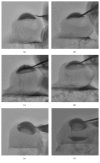In Vivo Imaging of Intraocular Fluidics in Vitrectomized Swine Eyes Using a Digital Fluoroscopy System
- PMID: 27127645
- PMCID: PMC4834173
- DOI: 10.1155/2016/9695165
In Vivo Imaging of Intraocular Fluidics in Vitrectomized Swine Eyes Using a Digital Fluoroscopy System
Abstract
Purpose. To describe the characteristics of intraocular fluidics during cataract surgery in swine eyes with prior vitrectomy. Methods. We prepared three groups of enucleated swine eyes (nonvitrectomized, core, and totally vitrectomized). Irrigation and aspiration were performed (2.7 mm conventional sleeved phacosystem) using a balanced saline solution mixed with a water-soluble radiopaque contrast medium at 1 : 1 ratio. We imaged the eyes using a digital fluoroscopy system (DFS) during phacoemulsification and compared the characteristics of the intraocular fluid dynamics between the groups. Results. The anterior chamber depth (ACD) after the commencement of irrigation differed between groups (2.25 ± 0.06 mm; 2.33 ± 0.06 mm; 3.17 ± 0.11 mm), as well as the height of the fluid flowing from the anterior chamber into the posterior cavity that was identified by lifting up the iris to correct the infusion deviation syndrome (0.00 ± 0.00 mm; 0.41 ± 0.04 mm; 2.19 ± 0.35 mm). Conclusions. DFS demonstrated differences in fluid dynamics during phacoemulsification in swine eyes with or without prior vitrectomy. In completely vitrectomized eyes, the large ACD, which developed during phacoemulsification, could be reduced by lifting the iris and allowing the fluid to shift to the posterior cavity. Recognizing the differences in fluidics of vitrectomized eyes as compared to those of the nonvitrectomized eyes may reduce the frequency of intraoperative complications.
Figures






Similar articles
-
Incidence of intraoperative complications during phacoemulsification in vitrectomized and nonvitrectomized eyes: prospective study.J Cataract Refract Surg. 2005 May;31(5):1011-4. doi: 10.1016/j.jcrs.2004.10.052. J Cataract Refract Surg. 2005. PMID: 15975471
-
A Modified Technique for Preventing Lens-Iris Diaphragm Retropulsion Syndrome in Vitrectomized Eyes during Phacoemulsification.J Pers Med. 2023 Feb 26;13(3):418. doi: 10.3390/jpm13030418. J Pers Med. 2023. PMID: 36983600 Free PMC article.
-
Intraocular pharmacokinetics of ranibizumab in vitrectomized versus nonvitrectomized eyes.Invest Ophthalmol Vis Sci. 2014 Jan 29;55(1):567-73. doi: 10.1167/iovs.13-13054. Invest Ophthalmol Vis Sci. 2014. PMID: 24398088
-
Cataract surgery results after pars plana vitrectomy.Curr Opin Ophthalmol. 2003 Jun;14(3):150-4. doi: 10.1097/00055735-200306000-00007. Curr Opin Ophthalmol. 2003. PMID: 12777934 Review.
-
Application of the Active-Fluidics System in Phacoemulsification: A Review.J Clin Med. 2023 Jan 12;12(2):611. doi: 10.3390/jcm12020611. J Clin Med. 2023. PMID: 36675540 Free PMC article. Review.
Cited by
-
Intraoperative Posterior Chamber Irrigation to Enhance Vitreous Cavity Support during Phacoemulsification Cataract Surgery after Vitrectomy.J Ophthalmol. 2020 Feb 17;2020:4132456. doi: 10.1155/2020/4132456. eCollection 2020. J Ophthalmol. 2020. PMID: 32148943 Free PMC article.
-
Fluid Supplementation Through Weakened Zonules via Side-Port Incision to Maintain Intraocular Pressure in High Myopic Eyes.Ophthalmol Ther. 2023 Dec;12(6):3323-3336. doi: 10.1007/s40123-023-00814-w. Epub 2023 Oct 9. Ophthalmol Ther. 2023. PMID: 37812307 Free PMC article.
-
Anatomic Studies of the Miniature Swine Cornea.Anat Rec (Hoboken). 2018 Nov;301(11):1955-1967. doi: 10.1002/ar.23890. Epub 2018 Oct 5. Anat Rec (Hoboken). 2018. PMID: 30288945 Free PMC article.
References
-
- Szijártó Z., Haszonits B., Biró Z., Kovács B. Phacoemulsification on previously vitrectomized eyes: results of a 10-year-period. European Journal of Ophthalmology. 2007;17(4):601–604. - PubMed
-
- Zaheer I., Taylor S. R. J., Pearson R. V. Phacoemulsification in vitrectomized eyes under topical anesthesia. European Journal of Ophthalmology. 2007;17(3):336–340. - PubMed
LinkOut - more resources
Full Text Sources
Other Literature Sources

